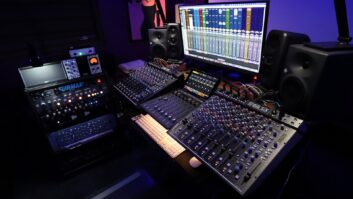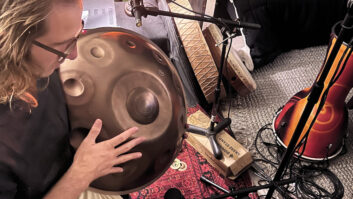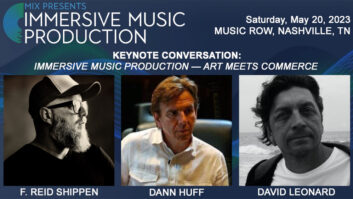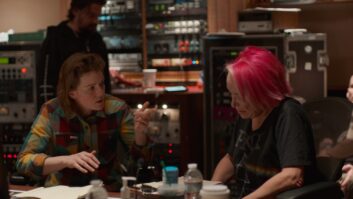Based on his youthful appearance and boyish exuberance, it’s hard to believe David Kershenbaum’s career spans more than two decades. The Springfield, Mo., native didn’t grow up in a musical mecca, but it was obvious that he was driven by a real passion for music. By 23, Kershenbaum was put in charge of RCA Records’ A&R Center in Chicago. Next, he became a creative force at A&M where he discovered and developed Joe Jackson. Jackson’s debut album, Look Sharp, made on a budget of $7,500, helped establish Jackson as a cornerstone of new wave music in the late ’70s. He followed that with Jackson’s I’m the Man, Night and Day, Body and Soul, as well as the innovative Big World.
Kershenbaum was responsible for signing Bryan Adams to A&M, and he produced Duran Duran’s Rio, Kenny Loggins’ Leap of Faith, had a hand in Tori Amos’ debut, and piloted Tracy Chapman’s self-titled debut (which garnered six Grammy nominations and won three, including Album of the Year) and the multi-Platinum follow-up Crossroads. Now Kershenbaum and Chapman are back on the charts again, with Telling Stories, which represents a reunion of artist, producer and musicians.
Are you usually hired as the guy who is going to give an artist a cohesive direction, or are you there strictly to preserve their vision?There are all different types of producers, from engineer/producers that do the sound and some production, to the producer almost being the artist who does the track and just drops a voice into it. I’ve always been what’s called an enhancement producer. I try to identify something in an artist that I can really relate to emotionally, musically and presentation-wise. I love to do what I call setting the stage-lighting the stage, putting the props out and getting the performances, to realize it into a finished product. I’ve always tended to gravitate toward great singers and then tried to figure out how to put the pieces together to realize what it is they were setting out to achieve.
You started out as a songwriter yourself.
I actually started as an artist, which very few people know, and I was on Capitol and Bell and a couple of different labels. I think I’ve safely gotten all the masters. I realized I was much more inclined towards, and gravitated towards, production. I loved music and wanted to do this since I was 3 years old. I taught myself to play the guitar, and I can remember putting a speaker in the backyard to do my little radio show for all the neighbors.
At 22, you were already making a mark as a staff producer for RCA in Chicago.It was different in those days. Today, you can get a very respectable home situation set up for not a lot of money that emulates most of the functions that you do in a big studio, so you’re able to learn with your hands on. In those days, you had to spend thousands of dollars to go into a big studio, and unless you were wealthy or someone believed in you, you didn’t have access to the equipment.
Where do you think you learned?It was interesting, because at RCA, I could not touch the board because they were union. But, obviously, I had friends who were engineers who would explain what they could. When I left RCA and went independent, I started going crazy trying to learn and do it myself, to the degree that when we were doing Joe Jackson and a lot of the earlier records, I would actually work with the engineer, but mix myself. Now, even though I have an engineer, we share in the duties. I always have my hands on it because it’s hard to explain to someone the emotion you’re feeling when you’re trying to move the faders or produce something. I call it layers of objectivity. It’s wonderful to have the engineer set up the mix and then come in totally fresh and hear it and then say, “Okay, let’s do this and this.” I think a technical and engineering background is a terrific asset in shaping what your vision is for the sound. Really, it’s the emotion and presentation of the sound matching the emotion of the song and the performance, and hopefully matching the lyrical content of what the song is saying. When that all comes together and works, it’s something bigger than the sum of all those parts. It ends up being something that breathes a life of its own. It’s hard to get all of those right. It’s a difficult task to get all of that to line up, but that’s the goal and if you can do that it makes for a great listening experience.
I assume artists you work with come in with varying degrees of pre-production done.
True, artists today are like producers. They have access to equipment and can try ideas. An artist today can bring you an incredible demo where they’ve fleshed out a lot of interesting ideas. Then you have to take it and shape it and maybe add another couple of layers of ideas to it, but there’s something to listen to. Sometimes that can work to the negative. Sometimes you don’t want to hear a lot of it because it influences you too much. I have found over the years that truly great artists can sit down with their guitar or at a piano and sing you the song, and it either gets you or it doesn’t. Anything more than that I think is trickery and manufactured. I call it painting by numbers because the job at that point is to fill in the blanks. It is almost more of an exercise in staying out of the way than in adding things.
I always start with the vocal. That’s going to be the centerpiece of that vast space between the speakers. And if the artist plays an instrument, usually they’ve tied their writing or their performance to their vocal and their instrument, and that states so much of what should happen. And then I just fill it in with rhythm first and then overdubs. I like to mix and record in sequence, so when you get to the end, you’re kind of hearing the finished record. I tend to not like to throw a lot of stuff on the tracks. Other people like to do all kinds of overdubs and figure it out in the mix, but I think it leaves too much to chance. I like to start with the vocal and build up accordingly so that at the end, everything is kind of in the position it’s going to be in, so you have a good sense of how it’s working as a whole. Still you have to do your effects and all the layers of presentation, but at least the skeleton of what you’re dealing with is in front of you and you can say it’s working or it’s not working.
Do your vocalists usually cut live?Most of them do. Music has gotten so sophisticated that you can put tracks together electronically, which I think has eliminated some of that live presentation of vocals that was so special in making records. No matter how good a singer is and no matter how able they are to lock back into emotion, there’s just something different about going back and singing and having a track follow you vs. you follow a track. The great way for me to make a record has always been to have the musicians respond to the singer, even if we replace it or fix it later. That’s where the play-off is-the push and pull and tug and jerk that has to do with the spark of the moment. So, even if I use electronic stuff, I’ll have the artist sing along with it. I tend to use a lot of live drums and live players and the artist will lead the way and will get the essence of what it’s supposed to be by performing with the musicians, which gives the musician a vibe to play with, too.
Let’s get specific about recording Tracy Chapman’s unique vocal.
Tracy is a dream and was when I met her early on in New York. When I first heard her sit and play and open her mouth, it sent shivers down my spine. The feeling was, “If I can capture this, it’s all over.” At that point in her career, she really hadn’t played with musicians, so it was a case where we had to figure out how we were going to record her. As you add things to acoustic music particularly, it changes it. At that time, I had my studio in L.A., and I had the idea of having Tracy play and sing and give the tape to a lot of different drummers and bass players to play with. I explained to them it wasn’t really a tryout, it was a case of something really special that would call for an unbelievably correct combination of players, because we weren’t going to use a lot of instruments. We had eight or nine different drummers and bass players to play underneath this vocal and guitar, and that’s how Denny [Fongheiser, drums] and Larry [Klein, bass] both ended up on Tracy’s record. It was the perfect match. It sounded as if it had always been there, and it didn’t change it a lot.
Tracy sang most of her vocals live, as she did on this new record. She’s an unbelievable singer and an unbelievable guitar player. Her time is really good, and her sense of rhythm and pitch is excellent, so we’re able to catch it as it goes. That intimacy was amazing on that first record, and I used the same combination on the second record. Of course, this is a reuniting of not only Tracy and me, but Denny and Larry played on this new record, too. Again, we started it with Tracy and her guitar, and everybody followed it. On this record, she sang her vocals live, and some of them we kept, and if we didn’t, she’d go back and sing the whole take live. She’s an amazing singer and absolutely spoils you.
What mic do you use on her?We tried different mics. She tends to sound good with Neumanns, and we use different mics for different things, but Tracy’s voice is really rich and full, and she sounds good on anything you put in front of her, from an old beat-up dynamic to a $6,000 microphone.
You don’t often get the chance to start with an artist and come back later and join the party again. I did it with Joe Jackson when we got back together on Night and Day. I don’t think I’ve ever seen an artist grow as much as Tracy has grown from the beginning to where she is now. Not only as a musician and singer, but her creative ideas were phenomenal on this record.
What kind of environment was Tracy in?We tried a couple of different things. There were two iso booths at the studio [Royaltone in L.A.], and we ended up, for sonic reasons, using the booth on the left. It was a fairly medium-dead room, but it provided access for her to be able to see Denny and Larry, and we could see her as well. We tried the other room on a couple of things and ended up going back to this particular room.
What kind of gear did you use?The album is an interesting hybrid of analog and digital. It combines what I think are the best elements of analog with the best elements of digital. It was mixed from a digital source, but it was done with a lot of analog ingredients, from all the different classic pieces, whether they be Neve or API, to try to come up with a sound that was really clear and dynamic, but not digital-sounding. It’s a much warmer-sounding digital. We made her first album completely digital; I had one of the early Mitsubishis.
You really heard a profound difference from doing it straight analog or straight digital?We did extensive testing of just that. We tried a couple of different digital formats, and we did a lot of comparisons all the way through to the mixing process-how much would stay on digital and how much would stay analog, what we would run through analog and what we would leave digital-and you can definitely hear the difference.
Digital is so precise. In the digital world, it doesn’t matter what format you’re using to store it to, it’s the converters that are the whole game. So in the digital world, the better your converters, the better shot you have at capturing exactly what the source was. A great digital converter shouldn’t add anything or take anything away; it should be true to the source. We found that the digital source was identical to what we were putting into it, but if we started with our analog source, we would have the best of both worlds. We’d have some of the warmth and some of the ability to have that friendlier analog sound, but store it really perfectly on digital so it always sounded like that. Analog starts to disintegrate right after you record it, and a couple of weeks or a month down the line, even if you don’t play the tapes, they change. Digital never changes, and if you get a really good transfer, then you’ve got it locked in. That was one consideration.
In the mixing, we concentrated primarily on Tracy’s voice-what was going to make Tracy sound as big and as airy and as full-bodied as we could make her sound and capture all that in a way that wouldn’t change through the mastering process? Again, if you mix to half-inch tape, you’ve got the same problem-by the time you master, it could change as well. Those were the things we were thinking about when we were trying these comparisons. But the truth is, what we seem to love is really distortion. So we were taking clean tracks that we had recorded and loved, and experimented with running them through different types of analog gear that would give them that little footprint. It was really interesting, because each one had its own footprint, so it was do you like this one or that one? We spent days painstakingly going through that kind of process.
What would create a difficult Tracy track?It gets down again to trying to get the rhythm of a group of people to match the rhythm of what she’s doing with her guitar and vocal. On the first record there was a song called “Mountains of Things,” which we tried to cut a few times with the band, but the live thing with live musicians just didn’t click. When we let Tracy and the percussionist do it and then added the things, it came right together.
You also worked with Tori Amos.
I only executive-produced that project. But it was the same situation-when I heard Tori at her piano, it was exactly like when I heard Cat Stevens or Tracy or Joan Baez, any of the great artists I’ve had the opportunity to work with. It was all there. You could sit and listen to her sing, and there was no doubt that she was going to be a star, and all you had to do was capture it and get everyone else to hear it.
You produced Joan Baez’s Diamonds and Rust.
I recorded Joan exactly like I did Tracy’s first album. It was all live, she sang and played, and it was all done around her vocals. She was able to sing her vocals live. Every artist has moments you have to fix, but the bulk of the performance is live. It’s a great singer who can do that. It’s a lot of pressure for the vocalist.
I think it’s a lot of pressure for the producer-not only to capture the magic but to not mess it up.
Sometimes the best production is no production. You really have to create a cavity for them to jump out of and not obstruct them. It’s really easy as you make a lot of records and learn a lot of techniques, to try to put tricks here and there, but what really makes a great musical performance in a record is a moment of that push-pull and tugging, opening up a verse and lifting into a B section and soaring into a chorus and then dropping everything back to a verse. You only have so much space between the speakers and a lot of people think the more you add, the bigger it gets, but I think it’s just the opposite. So the appropriate amount is a few things, but if you’re going to use a few things, they’d better be perfect. Space can be really scary. It’s very vulnerable-there’s nothing to hide behind.
It seems that when Tracy’s first album came out, we were coming out of an era of overdubs and perfection. That was a big chance you took.
Analytical to creative is a swing that goes back and forth. I couldn’t swear when we finished that first record with Tracy that radio would embrace it and it would get its moment, but I knew if it did, it would really make a mark on people’s emotional and musical make-up. What happened was something that none of us dreamed-the album was Gold before the single ever really got on the radio. It was one of those records where people still walk up to me and tell me exactly where they were and what they were doing when they first heard “Fast Car.”
Tell us about recording that single.
Again, Tracy sang it live. The difference between “Fast Car” and some of the other songs on the first album was when it hit the chorus, Denny really opened up with those big toms and that deep echo on the drums. That was a wonderful exercise in dynamics, because it was so vulnerable in both the message and presentation. It was Tracy and her acoustic guitar, Larry and a little rhythm from Denny. And it took a while to get to the chorus, which worried some people. It broke rules of great song construction, and I wouldn’t advise people to try it, but for some reason, it milked it so much that when it hit the release of the large chorus, it blew you over.
What was one of your toughest projects?Joe Jackson had a real dislike for recording studios later in his career. He loved to perform live, and his attention span was not great in the studio, so he’d look for ways to not do the typical recording process, which ultimately led to Big World, an attempt to record live in front of a live audience without recording live. We went direct to 2-track digital. We did it at the old Tammany Hall in New York over three nights. That was wild. We had to figure out a way to record it live, so we hired a remote truck and practiced it for a month. We went around to all these clubs and made templates. Michael Frondelli did one half of the board and I did the other half. When we got there, none of the acoustics were the same. We panicked, but we were able to pull it off.
We tried it on the album before, but the hall was acoustically wrong, and we couldn’t pull it off, so we ended up recording it directly to a multitrack. But this direct-to-2-track was mixed on the fly, and what you got is what you got. I can remember sweat just pouring down. On top of it, they insisted on having a film crew there, and when they turned on their lights the first night, it was incredible. Then on a real hard song that Joe just couldn’t quite get, one of the film guys got in front of him with the camera, and Joe stopped. But we ended up getting it, and it was done. The hardest part was that you had no recourse. You had to get it right from every aspect, from the standpoint of the mixing, the effects, the sound. He had to get his performance, and then we had to get ours simultaneously. Even in a live record you go back and fix things, but not in something like this.
You’ve worked with some eccentric artists who are known to be tough.
Sometimes you find artists who are just impossible. They are so destructive to themselves and the whole vibe and environment that it’s really hard to create to your full potential. Working with Tracy is optimum. She is someone you would treasure as your best friend. She’s smart, she’s bright and she creates a vibe for herself and everyone around that’s uplifting. Greatness can occur in that environment, vs. someone who is destructive. Drugs and drinking used to be a problem, and while you don’t see that so much anymore, what you do see is an artist who can sing and play beautifully when they’re not in front of a mic or there’s no red light on. Artists can be wacky people. They’re insecure, and all those defenses that cause them to be as great as they are, can also be their biggest detriment. I’ve seen artists ruin their records because they’re stubborn and belligerent.
With Tracy, I looked forward to going to the studio. It was long, and we worked hard, but we were excited to make the record. It was a fun, uplifting experience. We do this because we love music. The process can either make it possible for everyone to enjoy-to be and see what you feel with that artist in the room-or it can totally destroy all that. The big challenge, besides presentation, which is hard enough, is to make a seamless recording where the artist isn’t aware of the technology going on, but they’re just being themselves and flowing.







